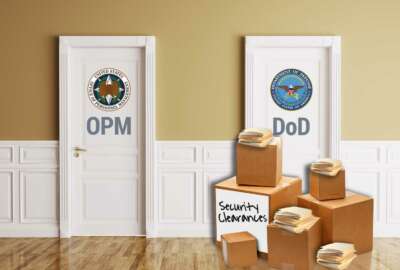Best listening experience is on Chrome, Firefox or Safari. Subscribe to Federal Drive’s daily audio interviews on Apple Podcasts or PodcastOne.
As the Trump administration considers moving the bulk of the governmentwide security clearance process back onto the Pentagon, the head of the National Counterintelligence and Security Center (NCSC) says his agency has a plan to cut the growing security clearance backlog.
Bill Evanina, the NCSC’s director in the Office of the Director of National Intelligence (ODNI), told members of the Senate Intelligence Committee on Tuesday that the security clearance process needs to be streamlined without sacrificing quality.
“Our government security clearance process is outdated and inefficient. It is currently undergoing a comprehensive overhaul. We plan, and will develop and implement, a process that results in the expeditious onboarding of qualified U.S. citizens both in the government and in cleared industry, with agility and reciprocity,” Evanina said at his confirmation hearing.
Evanina has already served as NCSC director since June 2014, but Congress elevated the position to require Senate confirmation in 2015.
Last month, Federal News Radio reported that the Trump administration has mulled whether to take the majority of the government’s security clearance review process from the National Background Investigations Bureau, and instead hand it back over to the Defense Department.
Citing a backlog of more than 700,000 cases and lengthy wait times to complete investigations, Sen. Mark Warner (D-Va.), the committee’s vice chairman, warned that the “system is broken.”
“This is a security risk, this is an economic risk, in terms of our ability then to brief companies,” Warner said.
Evanina told Warner that ODNI and DoD, together with the Office of Management and Budget and the Office of Personnel Management, are working on a “dramatic reduction” of the backlog and the development of a new business process to vet qualified security clearance holders.
That overhaul in the security clearance process, once implemented, “will probably get us to a position [where] we could estimate probably 20 percent reduction in the backlog within six months,” Evanina said.
However, Warner told Evanina that strategy still leaves hundreds of thousands of federal employees waiting for security clearances.
“That’s a little less ambitious than I think we discussed earlier,” Warner said.
Evanina responded by saying the 20 percent reduction in the backlog is “probably a conservative number.”
“I think some of the contingencies will be predicated upon the transfer of the NBIB inventory to DoD, and how that impacts the planned mitigation efforts,” he said.
Sen. Angus King (I-Maine) complained that having the security clearance process “scattered all over the government” makes it hard to hold any official accountable for the growing backlog.
“I can’t find out a single point — the single point in the United States government — that’s in charge of solving this problem,” King said.
Sen. James Lankford (R-Okla.) expressed concerns over whether the delayed wait for security clearances has kept the intelligence community from onboarding new recruits.
“Right now, it’s a ridiculous amount of time,” Lankford said.
Evanina told Lankford that NCSC is working toward an “end state” where a majority of secret and confidential-level clearances — about 80-90 of them — would get processed within 30 days.
Evanina said DoD should be able to get to that end state “within the next two years.”
“It’s a little more complicated at the top-secret level, as you’re aware, but we’re working on metrics as well,” he added.
Streamlining the security clearance process, he told Lankford, will help get new hires in the door faster.
“I believe that our mission in the intelligence community will win the day. The challenge is getting them in the door. I believe mission will keep them in for long periods of time,” Evanina said.
Right now, takes closer to 100 days to obtain a security clearance.
ODNI to deploy continuous evaluation system
NCSC remains on track to deploy its own fully functional continuous evaluation system by the end of the year.
Within that timeframe, Evanina says more than 20 agencies and 100,000 employees outside the intel community will have enrolled in the continuous evaluation plan.
While the concept has been “a constant bedrock” for the intelligence community for several years, according to Evanina, the NCSC system will vet federal employees and will check a wide array of databases for warning signs of insider threats.
The Defense Department has also been building its own continuous evaluation system.
Sen. Martin Heinrich (D-N.M.) questioned why civilian agencies are playing catch-up on a strategy that the defense and intelligence communities, along with the private sector, have already implemented.
“Industry is able to conduct continuous evaluation of their employees,” Heinrich said. “Why is it then difficult for the government to do so, and what can we do about it?”
Evanina said the intelligence community has long dealt with the risk of insider threats, and will provide that level of scrutiny for the rest of government.
“Although we’ll never eliminate the possibility of a bad actor within our walls, we continue to strive toward enhanced technical and behavioral solutions to prevent catastrophic damage as well as develop creative solutions to prevent and deter this activity,” he said.
Copyright
© 2024 Federal News Network. All rights reserved. This website is not intended for users located within the European Economic Area.
